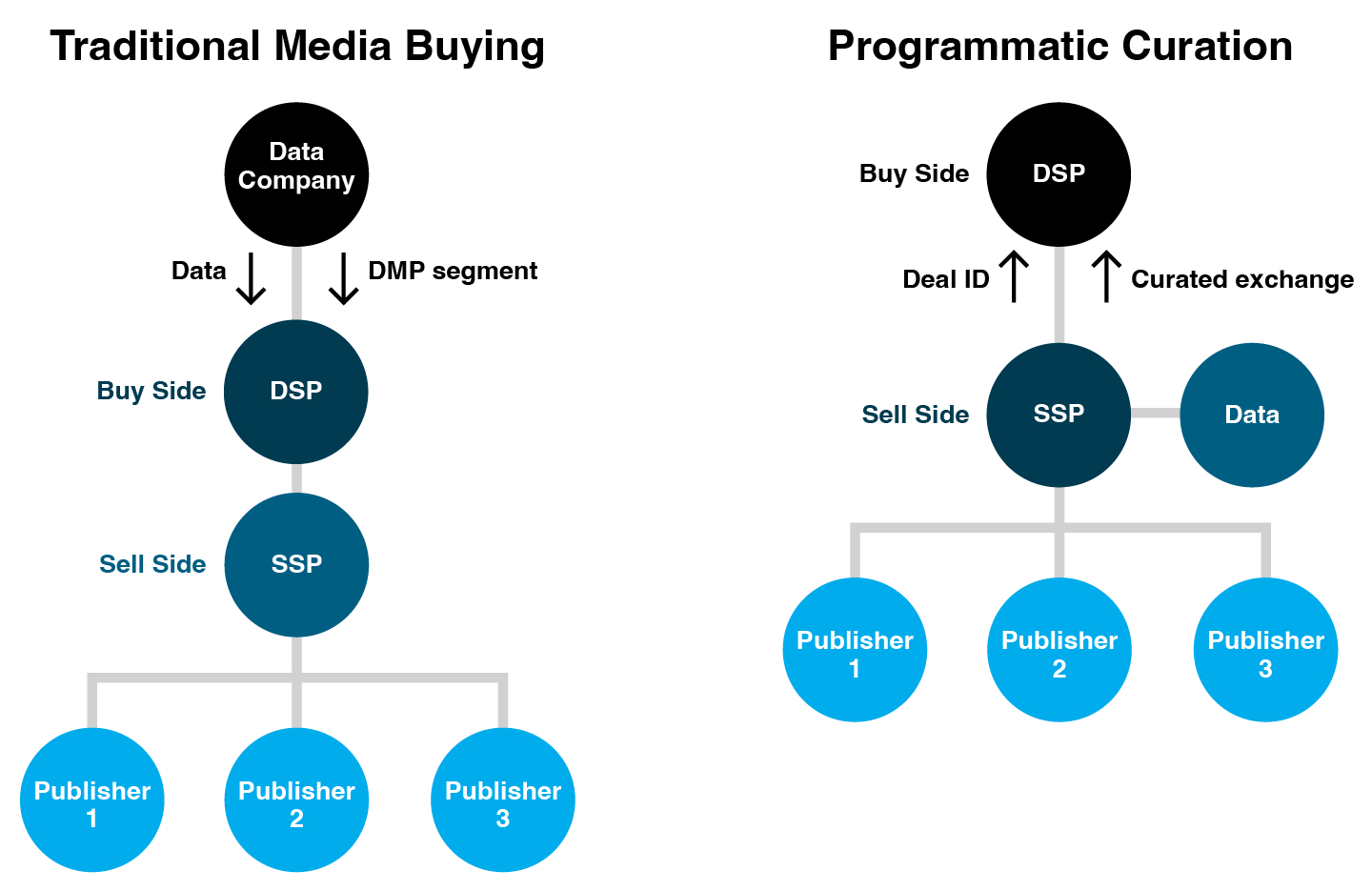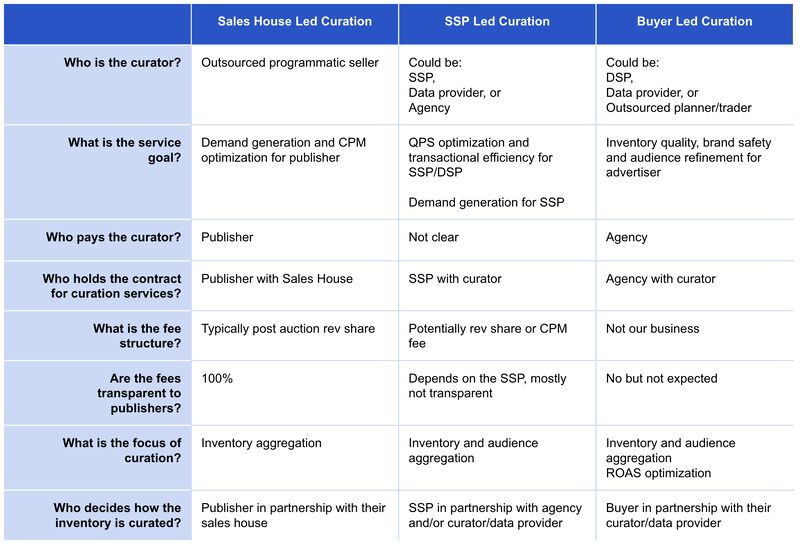A hot topic in digital advertising recently has been Programmatic Curation. As a result, the IAB Australia Exec Tech Council were keen to help support industry on this topic by providing some simple definitions and insights into the increased usage of Curation by sellers – hence this explainer.

A separate collaborative Q&A article on this topic can be found HERE – with members of our Exec Tech Council answering some related questions and adding more details, working examples and providing thought-leadership on how Curation can be meaningfully leveraged here in Australia.
What Is Programmatic Curation?
Programmatic curation is a tactic in which sellers leverage the capabilities within SSPs (supply-side platforms) to select and aggregate premium, brand safe ad inventory & enrich this pooled inventory with relevant audience targeting data, and advanced optimisation – prior to buyers receiving it via demand-side platforms (DSPs). The intention is to ensure that advertisers get efficient access to premium, brand-safe targeted ad placements that are more likely perform against their KPIs to make their ad buys more efficient, and as a result these types of curated supply are more valuable for all concerned.
The underlying approach is not necessarily new, as historically ad networks had been curating publisher supply for buyers in the pre-programmatic era for many years – and with enormous success. However, as programmatic buying erupted buyers could now use the targeting tools within their DSPs to cherry-pick their preferred supply & overlay these with audience data segments – shifting the direct sales negotiations and executions over into programmatic private marketplaces (PMPs). This change was ultimately the death knell for many of the more traditional ad networks.
More recently however, the sheer volume and scale of supply combined with ongoing signal loss has made the associated effort for buyers to filter and target meaningfully dramatically more difficult. Additionally, an increased focus on brand safety, concerns about wasted spends on MFA sites (made-for-advertising) and the ever increasing demand for improved general efficiency (including sustainability) has made the option of buyers accessing pre-curated supply for certain campaigns increasingly attractive.

image source: Ad Ambience
What Are The Potential Benefits For Buyers, Sellers & Ad Tech Vendors?
Whilst the practice of curation is not necessarily new and not particularly revolutionary (at first glance) its adoption has been dramatically increasing over the past 6 months, and to better understand why we’ll try to look into the top-level benefits across the industry.
Benefits for Buyers
- Enhanced Audience Segmentation & Scale – enables precise audience targeting for buyers with an option to scale campaigns across vetted premium supply, whilst still maintaining effectiveness.
- Mitigating Ad Fraud & Brand Safety Risks – helps eliminate low-quality or fraudulent supply, ensuring ads appear only in brand-safe, high-quality environments.
- Improved Efficiency & Controls for Buyers – simplifies the process for advertisers with better controls over ad placements and improving transparency, thereby reducing wasted ad spend.
Benefits for Sellers
- Premium Productisation – publishers can now better and more seamlessly monetise their genuinely premium inventory and audiences.
- Built Trust & Transparency – sellers can improve trust directly with buyers and build more consultative strategic partnerships to better understand advertisers’ wants and needs.
- Fight Fragmentation – for some highly fragmented opportunities such as CTV (Connected TV) curation can enable sellers to help buyers navigate a fragmented ecosystem by simplifying the available inventory selection, audience targeting attributes and measurement for buyers.
Benefits for Ad Tech Vendors
- Less Computational Effort – DSPs in particular have long battled the relentless increase in computational effort (measure in Queries Per Second) required for them to integrate with multiple parties and filter through in near real-time the ever-increasing accessible supply. Curation practices are naturally far more efficient and therefore more sustainable.
- SSP Product Evolution – curation is increasngly bringing back many of the campaign demands into SSPs, incentivising further product development and extending the capabilities for both buyers and sellers beyond their core solutions. This can only be a good thing.
- Increased Innovation & Diversity – ad tech is an industry built on genuine innovation and seeing the opportunity to build solutions that drive value for partners. The curation trend provides an opportunity for a new wave of tech creativity and potentially even a new category type of dedicated solutions and vendors.
What Are The Potential Considerations For Curation?
For all of the benefits of curation, it’s important to also provide some perspective on potential considerations for industry, as per the below:
- Exclusion of Smaller Publishers – curation may naturally favour larger publishers with more premium inventory, which could exclude smaller publishers or those with less curated inventory.
- Standardisation & Best Practices – as new programmatic buying types popularise the IAB will work to provide awareness, support and best practices. With this trend we are fortunate that standards that align to curation already exist (previously called Seller Defined Audiences, click here and see below for more info).
- Managing Costs – curated supply will be priced at a premium and hence buyers must look to factor in these additional costs into their buying strategies and ascertain when curated solutions are genuinely required to meet their needs.
- Over-Curation – as per a previous point, demand for increased volumes of premium curated supply may reduce the reach for buyers across valuable niche pockets of supply that don’t have resources to meet the validation and verification needs required to be included in some curated deals. Leveraging the standard tools available should suffice for certain campaigns, and this obviously is dependent upon the appetite for risk and solutions available.
- Ad-Hoc Marketplaces – a recent trend of note is that of curated marketplaces being embraced by some businesses that don’t necessarily have a traditional programmatic background (e.g. commerce networks & data providers). This is exciting to see, but may also require some increased diligence when vetting potential partnerships – and demanding full transparency over the related inventory, data sources and technologies being utilised.
General Guidance & IAB Tech Lab’s Curation Framework
Well over two years ago the IAB Tech Lab released the specifications for the Seller Defined Audiences (SDA) specifications, which in practice are standards for curation. Hence, IAB Tech Lab have recently renamed the specs as the Curation Framework, but the core framework remains the same:
Audience and Content Taxonomies – a common language for describing audiences & content with a specific focus on CTV.
Data Transparency – a standard way to label how an audience was made and is managed.
Supply Chain Object – transparency into who is selling the inventory and through which supply partners.
As the demand for curation has grown, IAB Tech Lab has also now proactively launched a dedicated working group (click here) based in the US to help support industry on related best practices. We will naturally keep the Australian industry updated on any outputs from this group.
Also – we will be touching upon this topic at our forthcoming Ad Tech & Ops event on 23rd July 2025 in Melbourne, Australia. For more info on this event simply click here
With any relatively new programmatic practice it’s always well worthwhile having your dedicated teams and/or partners invest time into assessing & researching the available opportunities for your organisation and then testing the requirements, available solutions and outcomes properly.
There can also be some confusion in how these solutions are presented to both buyers and sellers, as well as potentially what exactly the services are, who is providing real value and where the margins are being taken. As a result, I found the below table quite insightful as a very general guide.
Further insights will follow in the collaborative Q&A, a link to which will be included in this article once it has been published.
